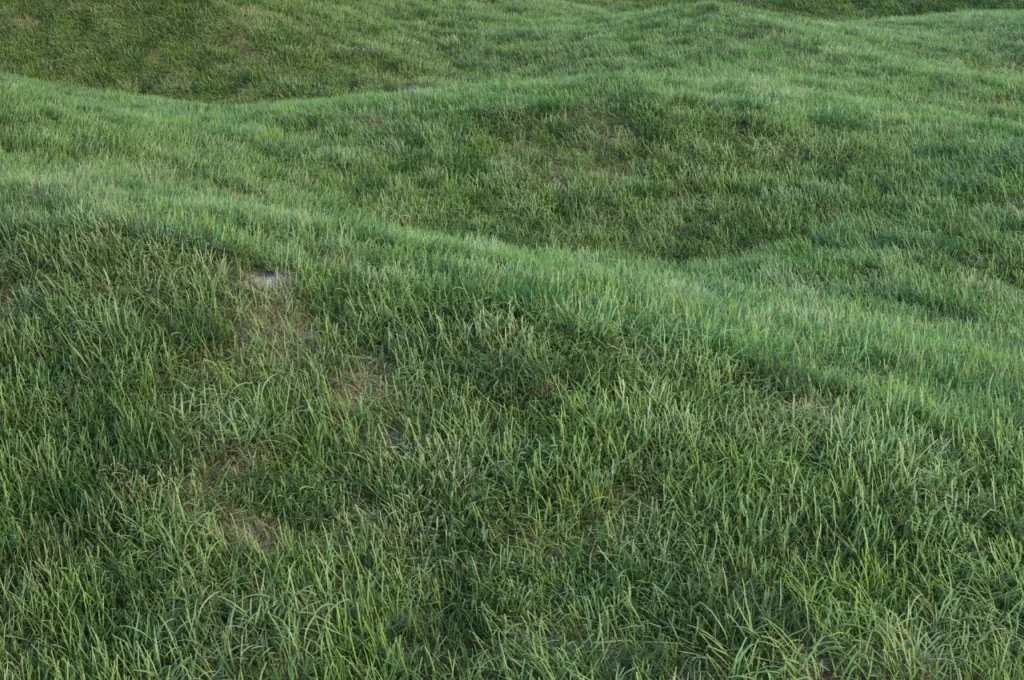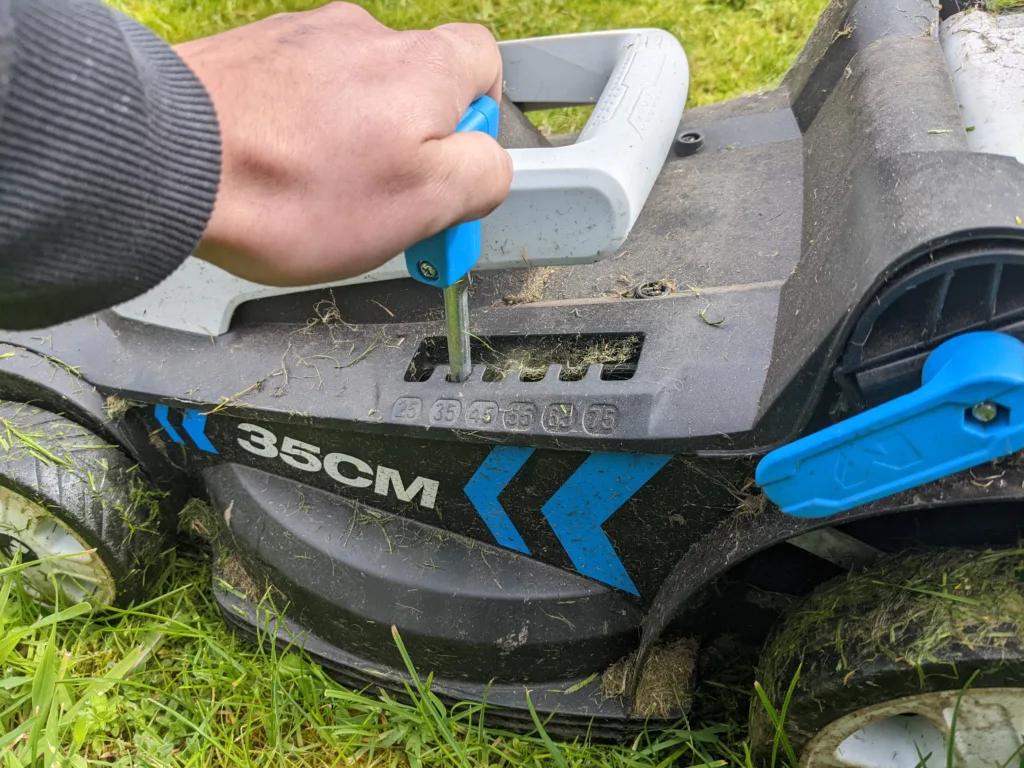Got an uneven lawn that needs mowing? In this guide, we’ve covered the best method of mowing an uneven lawn to achieve the neatest cut in the least amount of time.
✅Key Takeaways:
Your lawn might be uneven due to the presence of buried underground objects, leaking water or drainage pipes, animals, natural settling, or drainage problems.
Our top 5 tips for mowing an uneven lawn are:
Use a trimmer or strimmer to cut dipped areas
Raise the mower height to avoid scalping the lawn
Mow slowly and take your time
Switch up your cutting pattern
Manually trim around raised obstacles
Table of Contents
🏞 Why Are Some Lawns Uneven?
Ever wondered, “Why is my lawn uneven when my neighbours’ lawns are fine?”
There are a few reasons why some lawns are uneven, including:
Buried underground objects (including pipes and septic tanks)
Animals (such as moles)
Drainage issues
Mowing your lawn in the same pattern
Too much traffic on the lawn
Soil erosion due to damaged irrigation pipes/sprinkler system
Thin lawn causing patches of bare soil and weakening of areas
Depressions from heavy garden equipment
Natural settling
You might not know for certain why your lawn is uneven, but this information isn’t necessary to knowing how to mow an uneven garden.

🤔 Should You Mow An Uneven Lawn?
Ideally, you shouldn’t mow an uneven lawn. If your lawn is uneven, you’ll never get the quality of cut that you’ll get on a flat lawn, and you’ll make your job unnecessarily difficult.
Plus, mowing a lawn with uneven ground may worsen the problem and cause you to scalp your grass (cut it too short), leading to grown patches. You’re also at more risk of slipping or losing control of your mower if your lawn has a lot of steep slopes.
If you have a severely uneven lawn, we strongly recommend leveling your lawn before you attempt to mow it. But since you’re here because (we assume) you need to mow an uneven lawn, we’ve shared the best way to do it.
🏆 What’s The Best Lawn Mower For An Uneven Lawn?
The best lawn mower for bumpy or uneven lawns is a hover mower.
Hover mowers float on an air pocket above the surface of your lawn. They don’t have wheels, so they should avoid creating ruts and won’t bump up and down over your lawn’s surface as a conventional wheeled lawn mower would. Their hover design allows them to glide smoothly over uneven surfaces, adjusting to the contours of the ground.
There are a few features that make hover mowers more adaptable to uneven terrain:
Improved maneuverability. A hover mower’s floating design allows it to be easily manoeuvred around obstacles and across uneven areas with greater ease. This flexibility makes them capable of mowing lawns with bumps, slopes, and undulations.
Reduced scalping and lawn damage. Mowing uneven ground with a conventional wheeled mower makes it difficult to maintain an even cutting height. Using a hover mower should minimize the risk of scalping or cutting the grass too short in certain areas while leaving other areas untouched. Thanks to its hover design, the mower will distribute its weight more evenly and follow the contours of the ground, reducing the chances of damaging the lawn.
Lighter weight. Compared to some traditional wheeled mowers, hover mowers are often lighter to use. Being lighter and raised above your lawn reduces the mower’s impact on the ground and minimizes its likelihood of further damaging uneven areas. It also makes the mower easier to handle and manoeuvre, which is helpful when you’re dealing with challenging terrain.
Want to know which hover mower to buy for your UK garden? We recommend the Flymo EasiGlide 300 Hover Collect Lawn Mower because it’s currently the most popular and best-rated hover mower on Amazon – and it’s a great budget pick, too, costing just over £100.
📑 5 Tips For Mowing An Uneven Lawn
If you have no choice but to mow an uneven lawn, follow these 5 tips to achieve the best quality cut with as little effort on your part.
✂️ Tip 1: Use A Strimmer For Dipped Areas
You’re probably well aware of your lawn’s unique terrain, including the location of the lawn’s dips and bumpy areas.
Before you get your mower out, start by strimming these dips and bumps, making sure to cover any depressions in the ground that might not be picked up by your lawn mower.
This should help you to attain a more even overall cut, and you won’t have to waste time trying to manoeuvre your mower over these bumpy areas at an angle that will cut the grass in the dipped or sunken areas.
📏 Tip 2: Raise The Mower Height
Once you do bring out your lawn mower, set the mower deck height to a higher setting to accommodate the uneven areas.
This should help prevent scalping as you mow over bumps because the mower blades should be high enough to avoid cutting the grass too short, even when approaching parts of your lawn at a low angle.
Mowing with a higher cutting height also gives the grass a chance to grow taller, which can help even out the appearance of your lawn and make those lumps and bumps less visible.

🐢 Tip 3: Take It Slowly
Perhaps you find mowing a chore and want to get the job done as quickly as possible. But if your lawn is uneven, it’s important to take your time and mow at a slower pace.
Slower mowing allows you to navigate bumps and dips more effectively and reduces the chances of damaging the lawn or losing control of the mower.
You can better see what you’re doing and make more calculated movements when you’re mowing at a slower pace, which means you can approach uneven areas at a better angle and minimize issues with scalping.
🔁 Tip 4: Mow In Different Directions
Certain bumpy or hilly sections of your lawn are best approached from a particular angle. When mowing on uneven terrain, it’s always best to mow horizontally along the uneven section where possible, rather than mowing straight up and over the bump.
This might mean mowing in different directions as you address different uneven sections of your lawn. You’ll probably have to shelve your desire to achieve a beautifully striped lawn for the time being – mowing in straight lines is best for even, level lawns, and not always practical for bumpy lawns.
Mowing in different directions also prevents the grass blades from leaning in one direction, which makes the bumps and depressions in your lawn more visible.
✂️ Tip 5: Trim Around Obstacles Manually
If you have raised obstacles on a mound or hill in your garden, it’s best to trim around them manually using a string trimmer or handheld clippers.
This will give you more control and help you to avoid accidental damage to the obstacles or your mower.

🏁 Final Word
Ultimately, if your lawn has mildly uneven areas, we recommend that you level your lawn rather than continuing to mow it while it’s uneven. Lawn leveling is actually a pretty simple job that you can do yourself – no need to hire a landscaper or rent out a digger.
To level your lawn, rake the grass to remove excess thatch, then mix two parts topsoil or potting soil, two parts fine sand or play sand, and one part compost. Use a shovel to apply the leveling mixture to dips, then compact the mix with your foot. Repeat this process until the dips are all levelled out, then spread grass seed evenly over the areas and water it daily until the seeds have sprouted and you notice new grass growth.
Once you’ve got your lawn level, you won’t have to worry about taking special steps to mow your lawn because it’ll be nice and flat.
If your lawn is severely uneven, it might make more sense to rip it out and establish a new lawn.

